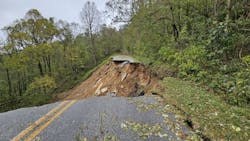Infrastructure Must Modernize
By Kelsey Kidd, Contributing Author
As significant weather events have become more frequent and devastating across the U.S., as evidenced by the two most recent hurricanes that battered the Southeast, the threat to the stability, resiliency and structural integrity of the nation’s bridges, highways and roads continues to grow.
By any number of reports and statistics, the general state of U.S. civil infrastructure is poor even without factoring in extreme heat, wildfires, flooding and increasingly violent storms witnessed in just the past few years. According to the American Road and Transportation Builders Association (ARTBA), one in three bridges requires either repair or complete replacement. Meanwhile, more than $1 trillion is sorely needed to address highway repairs across the country.
All studies and analyses point to the same conclusion: U.S. critical infrastructure, including highways, roads, and bridges, is not prepared to withstand the impacts of climate change that grow more pronounced with each passing year.
The arteries so many people depend upon daily for basic travel, commuting to and from work, and connecting with one another are increasingly at risk for failure or collapse.
Conducting all the needed repairs and enhancements to the nation’s roads and bridges will take time and require significant funding that is always difficult to procure but even more so in a highly polarized political environment.
Therefore, in the meantime, the onus falls on operators, safety consultants and engineers to closely monitor the condition of these structures to spot deficiencies as soon as possible and allocate resources, including capital, manpower and equipment, to the roads and bridges that need the most attention.
This expansive, round-the-clock degree of monitoring simply cannot be done by humans alone. It is simply not feasible and would be incredibly costly, especially considering the number of critical structures at risk across the country. The risk is too great to allow weeks to pass between in-person, and physical inspections.
This is why structural engineers, safety consultants and any organization responsible for civil infrastructure safety must more readily embrace technology and deploy digital solutions that can monitor more effectively and heighten awareness and resilience.
As weather becomes more extreme, a more modernized approach to monitoring is needed to avert disaster and potentially save lives.
Today, advancements in IoT (Internet of Things) and low-power radio technologies, or LoRa, make this possible. Connected sensors and devices attached to any highway, bridge, overpass or road can detect vibrations, and any changes in tilting, and gauge the impact of extreme temperatures on the integrity of the structure. These sensors remotely capture data for transmission via software systems and applications.
For example, a tiltmeter can be deployed to monitor the tilt of bridges or highway overpasses susceptible to strong winds. Flood monitoring systems can be used to accurately monitor water level parameters, which can prevent travel routes from being impacted by surface-level floods. And any vibrational effects on roads can be measured by using a vibration meter.
Monitoring systems such as these are easy to deploy and require little ongoing maintenance. Engineers can receive continuous data flows and monitor the stability of structures from afar, receiving alerts to any dramatic or worrisome changes and deploying teams to where repairs are needed most. The many different companies and entities with varying levels of responsibility for the design, construction, and maintenance of civil infrastructure assets can all have access to the same data at the same time.
Historically, infrastructure maintenance has been reactive. Crews are typically deployed in the field only after an urgent situation arises or, sadly, after a failure has occurred. As weather events continue to stress the nation’s roads and bridges, those urgent situations are likely to increase in volume.
A technology-enabled approach to monitoring can help engineers and safety consultants identify deficiencies in real-time, before failures happen, helping us learn to live better and more safely amid the new climate realities.
Kelsey Kidd is North American Sales Director for Worldsensing, a provider of IoT solutions for monitoring critical infrastructure.
